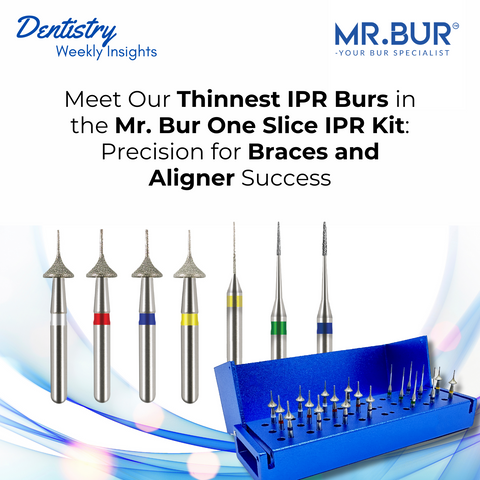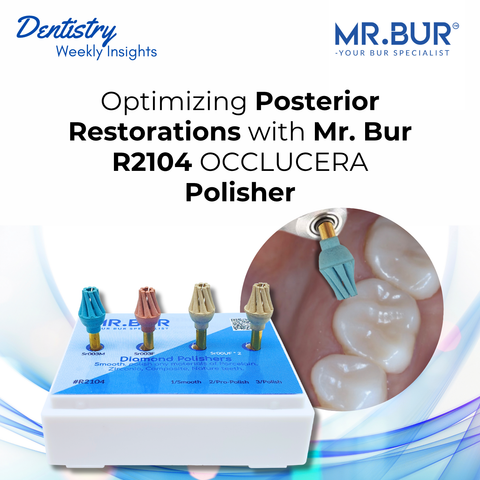Sebagai dokter gigi, pemilihan antara veneer tanpa persiapan (persiapan minimal) dan veneer konvensional melibatkan penilaian kebutuhan pasien, kondisi klinis, dan tujuan estetika. Sementara veneer tanpa persiapan sering kali tidak memerlukan reduksi email, reduksi interproksimal (IPR) menggunakan bur IPR dapat mengatasi masalah seperti segitiga hitam. Untuk veneer dengan persiapan minimal dan konvensional, Persiapan Veneer Mr. Bur Depth Marker Diamond Bur FG memastikan pengurangan enamel yang presisi. Blog ini merinci kapan harus memilih setiap jenis veneer, aplikasi klinisnya, dan bagaimana depth marker dan IPR bur Mr. Bur meningkatkan hasil veneer di praktik Anda.
Memahami Veneer Gigi dalam Praktik Klinis
Veneer adalah lapisan tipis porselen atau resin komposit yang direkatkan pada permukaan depan gigi untuk meningkatkan estetika atau mengembalikan fungsi. Veneer mengatasi:
-
Perubahan warna yang parah (misalnya, pewarnaan tetrasiklin)
-
Gigi terkelupas, aus, atau tidak rata
-
Segitiga hitam, celah, atau ketidaksejajaran kecil
Untuk persiapan veneer konvensional dan minimal, Mr. Bur Depth Marker Veneer Preparation Diamond Bur FG , dengan lapisan berlian 3 lapis dan desain stopper, menghasilkan potongan kedalaman yang akurat (0,3–0,7 mm). Untuk veneer tanpa persiapan yang menangani segitiga hitam, bur IPR memfasilitasi reduksi email interproksimal yang presisi. Kedua alat, tersedia di www.mrbur.com, mengoptimalkan kecocokan veneer dan hasil estetika.
Veneer Tanpa Persiapan (Persiapan Minimal): Solusi Konservatif untuk Kasus Estetika
Apa itu Veneer Tanpa Persiapan (Persiapan Minimal)?
Veneer tanpa persiapan tidak memerlukan reduksi email pada permukaan wajah, sedangkan veneer persiapan minimal memerlukan reduksi sedikit (0,3–0,5 mm). Terbuat dari porselen feldspar atau litium disilicate (misalnya, e.max), veneer ini mempertahankan struktur gigi, menawarkan pilihan konservatif yang seringkali dapat dibalikkan untuk peningkatan estetika.
Kapan Memilih Veneer Tanpa Persiapan (Persiapan Minimal)
Pilih veneer tanpa persiapan atau persiapan minimal untuk pasien dengan:
-
Masalah Estetika Minor : Noda kecil, diastema kecil, atau ketidaksempurnaan permukaan.
-
Segitiga Hitam : Ruang interdental akibat resesi gingiva atau bentuk gigi, dapat diperbaiki dengan veneer tanpa persiapan dan IPR.
-
Enamel Sehat : Enamel tebal (0,5–1,0 mm) tanpa restorasi atau ketidakselarasan yang signifikan.
-
Preferensi Konservatif : Pasien yang mencari intervensi minimal atau reversibilitas.
-
Estetika Alami : Keinginan untuk peningkatan senyum yang tembus cahaya dan halus.
Mempercantik Veneer Tanpa Persiapan dengan IPR untuk Segitiga Hitam
Bahasa Indonesia: Untuk veneer tanpa persiapan, reduksi email wajah biasanya tidak diperlukan, jadi Bur Penanda Kedalaman Mr. Bur tidak digunakan. Namun, untuk mengatasi segitiga hitam , Anda dapat menggunakan bur IPR untuk melakukan reduksi interproksimal, menghilangkan 0,2–0,5 mm email di antara gigi. Ini membentuk kembali titik kontak, yang memungkinkan veneer tanpa persiapan untuk menutup ruang interdental secara efektif. Pemotongan bur IPR yang halus dan terkontrol memastikan kehilangan email minimal, menjaga integritas gigi sekaligus meningkatkan estetika. Untuk kasus persiapan minimal yang memerlukan reduksi wajah sedikit, Bur Penanda Kedalaman Mr. Bur pada 0,3 mm mengukir alur yang tepat, memastikan reduksi email tetap dalam 0,3–0,5 mm untuk ikatan veneer yang optimal.
Manfaat Klinis Veneer Tanpa Persiapan (Persiapan Minimal)
-
Pendekatan Konservatif : Tanpa persiapan mempertahankan enamel wajah; persiapan minimal mengurangi sensitivitas.
-
Penutupan Segitiga Hitam : IPR dengan veneer tanpa persiapan mengoreksi ruang interdental tanpa pengurangan wajah.
-
Reversibilitas : Tanpa persiapan seringkali dapat dibalikkan; persiapan minimal kurang invasif.
-
Efisiensi : Memerlukan 1–2 kunjungan, menyederhanakan alur kerja.
-
Integrasi Estetika : Bahan tipis dan tembus cahaya menyatu secara alami.
Pertimbangan Klinis
-
Indikasi Terbatas : Tidak cocok untuk perubahan warna parah atau maloklusi yang signifikan.
-
Ketebalan Enamel : Verifikasi kecukupan enamel untuk IPR atau persiapan minimal melalui radiografi.
-
Kasus Segitiga Hitam : Pastikan kesehatan gingiva dan kesesuaian pasien untuk IPR.
Contoh Kasus : Untuk pasien dengan segitiga hitam akibat bentuk gigi segitiga, gunakan bur IPR untuk mengurangi 0,3 mm di bagian interproksimal, lalu pasang veneer tanpa persiapan untuk menutup ruang tersebut, sehingga memperoleh senyum yang mulus tanpa persiapan wajah.
Veneer Konvensional: Solusi Kuat untuk Kasus Kompleks
Apa itu Veneer Konvensional?
Veneer konvensional, 0,6–1,0 mm atau lebih, memerlukan pengurangan enamel sedang hingga signifikan untuk mengatasi masalah estetika atau fungsional yang kompleks. Terbuat dari zirkonia atau porselen berkekuatan tinggi, veneer ini memberikan daya tahan untuk restorasi yang luas.
Kapan Memilih Veneer Konvensional
Pilih veneer konvensional untuk pasien dengan:
-
Koreksi Estetika Utama : Noda parah, bentuk gigi tidak rata, atau celah besar.
-
Gigi yang Rusak : Retak, terkelupas, restorasi besar, atau keausan akibat bruxism.
-
Penyesuaian Oklusal : Kerumunan sedang, rotasi, atau koreksi gigitan.
-
Transformasi Dramatis : Keinginan untuk senyum Hollywood yang seragam dan menonjol.
Mempercantik Veneer Konvensional dengan Mr. Bur Depth Marker
Untuk veneer konvensional, Mr. Bur Depth Marker Bur pada 0,5–0,7 mm mengukir potongan dengan kedalaman yang seragam untuk mengakomodasi bahan yang lebih tebal. Sumbat bur memastikan reduksi yang presisi, meminimalkan paparan dentin, sementara lapisan berlian 3 lapisnya menciptakan alur yang halus untuk ikatan veneer yang kuat. Dengan irigasi air, bur mengurangi panas dan kotoran, menghasilkan permukaan persiapan yang bersih untuk veneer porselen atau zirkonia yang tahan lama.
Manfaat Klinis Veneer Konvensional
-
Aplikasi Luas : Mengatasi tantangan kosmetik dan fungsional yang kompleks.
-
Daya Tahan Tinggi : Bahan yang lebih tebal menahan gaya oklusal dan keausan.
-
Desain yang Dapat Disesuaikan : Memungkinkan pembentukan ulang atau pemanjangan yang signifikan.
-
Restorasi Fungsional : Membangun kembali tepi insisal dan mengoreksi dinamika gigitan.
Pertimbangan Klinis
-
Sifat Invasif : Tidak dapat dipulihkan karena hilangnya email secara signifikan.
-
Risiko Sensitivitas : Terpaparnya dentin dapat menyebabkan sensitivitas sementara, sehingga memerlukan pengikatan yang hati-hati.
-
Kesehatan Gingiva : Margin subgingiva perlu ditempatkan secara tepat untuk menghindari iritasi.
Contoh Kasus : Untuk pasien dengan gigi seri yang terkelupas dan berputar, gunakan Mr. Bur Depth Marker Bur pada 0,7 mm untuk mempersiapkan gigi untuk veneer porselen konvensional, memastikan ruang untuk senyum yang tahan lama dan dibentuk ulang.
Membandingkan Veneer Tanpa Persiapan (Persiapan Minimal) vs. Veneer Konvensional dengan Mr. Bur Precision
|
Fitur |
Veneer Tanpa Persiapan (Persiapan Minimal) |
Veneer Konvensional |
|
Ketebalan |
0,3–0,5 mm |
0,6–1,0 milimeter+ |
|
Penghapusan Enamel |
Tidak ada (tanpa persiapan) atau minimal (0,3–0,5 mm) |
Sedang hingga signifikan |
|
Indikasi |
Estetika minor, segitiga hitam |
Koreksi besar, gigi rusak |
|
Tuan Bur Tool |
Bur IPR (tanpa persiapan); Penanda Kedalaman 0,3 mm (persiapan minimal) |
Penanda Kedalaman 0,5–0,7 mm |
|
Reversibilitas |
Seringkali reversibel (tanpa persiapan) |
Tidak dapat diubah lagi |
|
Waktu Prosedur |
1–2 kunjungan |
2–3 kunjungan |
|
Daya tahan |
Sedang (fokus estetika) |
Tinggi (fokus fungsional) |
Alur Kerja Klinis dengan Penanda Kedalaman Mr. Bur dan Bur IPR
-
Penilaian Diagnostik : Mengevaluasi ketebalan email, oklusi, dan segitiga hitam menggunakan radiografi atau pemindaian digital.
-
Pemilihan Alat : Untuk veneer tanpa persiapan dengan segitiga hitam, gunakan bur IPR; untuk persiapan minimal, pilih Mr. Bur Depth Marker Bur pada 0,3 mm; untuk veneer konvensional, gunakan 0,5–0,7 mm.
-
Persiapan : Untuk tanpa persiapan, lakukan IPR guna membentuk ulang area interproksimal; untuk persiapan minimal atau konvensional, ukir alur wajah dengan sumbat bur penanda kedalaman yang mengontrol kedalaman, menggunakan irigasi air.
-
Penyempurnaan Margin : Ratakan margin dengan bur Mr. Bur tambahan (misalnya, dari Veneer Preparation Kit FG ) untuk ikatan optimal.
-
Verifikasi : Konfirmasikan persiapan dengan wax-up diagnostik atau desain senyum digital.
Memilih Veneer yang Tepat untuk Pasien Anda
-
Veneer Tanpa Persiapan (Persiapan Minimal) dengan Bur IPR atau Depth Marker dari Mr. Bur : Terbaik untuk pasien dengan email sehat yang membutuhkan peningkatan halus atau penutupan segitiga hitam. Tanpa persiapan menggunakan IPR untuk pembentukan ulang interdental, sementara persiapan minimal menggunakan bur penanda kedalaman 0,3 mm untuk sedikit pengurangan wajah, memberikan hasil yang alami dan konservatif.
-
Veneer Konvensional dengan Penanda Kedalaman Mr. Bur 0,5–0,7 mm : Ideal untuk pasien dengan gigi yang rusak atau kebutuhan estetika/fungsional yang signifikan, memberikan hasil yang tahan lama dan transformatif.
Kiat Klinis : Gunakan desain senyum digital untuk melihat hasil dan menyesuaikannya dengan harapan pasien. Untuk kasus segitiga hitam, konfirmasikan kesesuaian IPR dengan contoh diagnostik, pastikan presisi dengan bur IPR milik Mr. Bur.
Rekomendasi Perawatan Pasca Penempatan
Anjurkan pasien untuk mempertahankan veneer selama 10–15 tahun dengan:
-
Kebersihan Mulut : Menyikat gigi dua kali sehari, membersihkan gigi dengan benang gigi, dan menggunakan pasta gigi non-abrasif.
-
Tindakan Pencegahan Diet : Hindari menggigit benda keras untuk mencegah terkelupasnya.
-
Perlindungan Oklusal : Resepkan pelindung malam khusus untuk para penderita bruxism.
-
Tindak Lanjut Rutin : Jadwalkan pembersihan dan pemeriksaan dua kali setahun.
Kesimpulan: Tingkatkan Praktik Veneer Anda dengan Mr. Bur Precision
Baik memasang veneer tanpa persiapan untuk menutup segitiga hitam dengan bur IPR atau membuat veneer konvensional dan persiapan minimal dengan Mr. Bur Depth Marker Veneer Preparation Diamond Bur FG , peralatan Mr. Bur memberikan presisi dan efisiensi. Bur IPR memastikan reduksi interproksimal terkontrol untuk kasus tanpa persiapan, sementara bur penanda kedalaman 0,3 mm dan 0,5–0,7 mm masing-masing mendukung persiapan minimal dan konvensional. Integrasikan peralatan tepercaya ini ke dalam praktik Anda untuk mencapai hasil veneer yang konsisten dan berkualitas tinggi yang meningkatkan hasil perawatan pasien.
Jelajahi Depth Marker dan IPR Burs Mr. Bur di www.mrbur.com dan tingkatkan persiapan veneer Anda hari ini!
Diamond Burs , Carbide Burs , Surgical & Lab Use Burs , Endodontic Burs , IPR Kit , Crown Cutting Kit , Gingivectomy Kit , Root Planning Kit , Orthodontic Kit , Composite Polishers , High Speed Burs , Low Speed Burs


